Summary
Increases in tuition across California’s public four-year universities have heightened concerns about the affordability of a college education, especially for those with the lowest incomes. In-state full tuition at the University of California (UC) and California State University (CSU) has risen more dramatically than at other public universities in other states over the past decade. During this same period, the federal, state, and institutional grant and scholarship programs that help make college affordable for students from lower- and middle-income families expanded. This helped lower-income families keep up with rising tuition, but the full price of college beyond tuition can still be a relatively large share of their income. Given the importance of higher education to California’s economic future, policymakers at the federal, state, and institutional levels need to make a continuing commitment to keep college affordable for students from low- and middle-income families. Also, given current tuition levels, it is more important than ever for the state to ensure that all students fill out financial aid forms and can easily access tools that can help them understand the financial aid packages they are offered.
The Rising Price of College
The cost of attending California’s public four-year universities is at an all-time high, largely due to tuition increases over the past decade.1 From 2004 to 2013, the average tuition at UC and CSU more than doubled from around $4,000 to more than $9,000.2 These increases are a source of concern for Californians who fear that they may be priced out of postsecondary education or forced to borrow more money to complete their degrees. A PPIC Statewide Survey conducted in December 2012 found that almost two-thirds of Californians think that the affordability of higher education is a big problem.3 What may not be widely known is that increasing and targeted federal, state, and institutional financial aid play a big role in lowering the cost to students and families and thus making college affordable for middle- and low-income students. Knowing how college costs differ among students can help frame the debate about rising college costs and the accessibility of higher education in California.
California’s Tuition Increases in Context
In California, students and taxpayers each pay part of the bill for public higher education. The state provides money from its General Fund to subsidize a portion of each student’s higher education, and the students are responsible for another part through tuition and fees. During the recent recession, the California Legislature cut General Fund support for UC and CSU by about 20 percent, shrinking the state’s contribution from $6.2 billion in 2007 to $5.0 billion in 2013.4 The universities responded by shifting more of the burden to the student through higher tuition. Tuition increases at public universities were common throughout the U.S. over this period.5 In California, however, the tuition increases have been particularly acute. (Figure 1). California was below the median (34th) average public four-year college tuition in 2004, but by 2013 the state’s average tuition ranked 21st.6
Figure 1. tuition increases across states
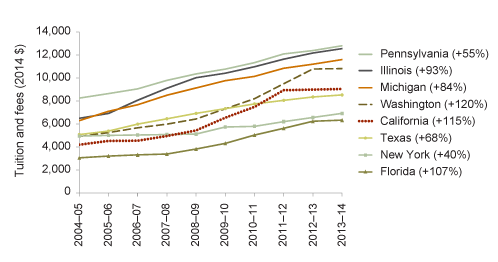
SOURCE: College Board.
NOTES: Data from the College Board come from all public four-year universities in the state; for California, that includes all of CSU and the nine undergraduate UC schools. Tuition represents combined tuition and fees. While no state is exactly like California, the figure includes the states with the largest systems of public universities (NY, TX, PA, FL) as well as other large states with prestigious public institutions (WA, IL, MI). Data are presented on a student-weighted basis.
California’s dramatic tuition increases have led many to believe that institutional expenditures are out of control. But, as is shown in a companion report, these increases reflected not only the impact of the recession on California’s economy and state finances, but also the vulnerability of higher education funding relative to other major state budget categories.7 With the economy on the upswing, California voters passed Proposition 30, which was designed in part to provide more funds for higher education. In 2013, Governor Brown effectively froze tuition by promising to include annual funding increases for UC and CSU in his budget if tuition remains at 2011-12 levels through 2016-17. Tuition levels have not increased over the past three years but are still at all-time (nominal) highs.
Net vs. Full Tuition
To help cover the cost of college, students can receive a mix of grants and scholarships from federal, state, institutional, and private sources. This grant and scholarship aid is usually based on financial need and/or academic achievement. For example, low-income students can get a federal Pell Grant of up to $5,500. The state’s Cal Grant program provides $12,192 toward the full price of college at UC campuses and $5,472 at CSU campuses for students from low-income families. Undocumented immigrants, who are not eligible for federal grants, can benefit from California’s financial aid programs through the California Dream Act.8 California’s public universities can supplement state and federal aid with their own institutional funds. UC’s Blue and Gold Opportunity Plan ensures that eligible students from families making less than $80,000 per year have their full tuition and fees paid through some combination of state, federal, and institutional aid. CSU’s State University Grant ensures the same for certain low-income families. Recently, the Middle Class Scholarship program, enacted by the legislature in 2013, extends state aid even further, providing some support to students from families with annual incomes up to $150,000. With the varied sources of financial aid the total aid a student receives can extend beyond tuition to cover room and board, books, and other educational expenses.
In other words, students at the same institution pay differing amounts of “net tuition.” Net tuition is the full tuition price minus grant and scholarship aid that a particular student receives. For example, the University of California, Davis, has a full tuition of $13,902. If a student enrolling at UC Davis receives a $5,500 Pell Grant and a $6,000 Cal Grant, his or her net tuition would be $2,402. Students from families with the lowest incomes usually get the largest financial aid packages and therefore pay the lowest net tuition. Net tuition is highly individual, however. Students with the same family income may have a different net tuition depending on other individual factors like family size and academic performance. Figure 2 shows the average net tuition for UC and CSU students who received federal financial aid, broken down into four family income ranges.9 On average, students from families with incomes of less than $75,000 who receive federal financial aid pay little to no tuition at either CSU or UC. Even families making up to $110,000 pay less than full tuition if they receive federal financial aid of some kind.
Figure 2. net tuition for csu and uc
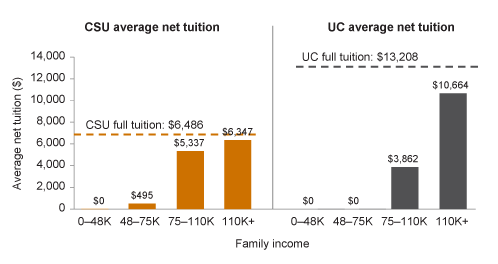
SOURCE: Author calculations based on data from Integrated Postsecondary Education Data System (IPEDS).
NOTE: Average net tuition for 2011-12, calculated as average tuition and fees at the system minus the average amount of grants and scholarships for first-time, full-time students who receive some form of federal financial aid. The calculations assume grants and scholarships are applied to tuition and fees first, rather than toward other expenses. Average net tuition and full tuition for the systems are weighted by student.
There are some important details to note about the data used for these calculations. The data include only students who filled out a Free Application for Federal Student Aid (FAFSA) form and received some sort of federal financial aid (including subsidized loans). This affects the average net tuition calculations in two ways. First, students who are not eligible for financial aid do not appear in the data. These students probably owe the full tuition and are probably in the top family income categories, or have family assets that preclude them from aid. Second, students who fail to apply for federal financial aid even if eligible will not receive grants from the federal government or the state of California, and so will pay higher net tuition regardless of income category.10 For example, a student from a family making less than $75,000 who does not apply for federal financial aid will likely owe full tuition, unless he or she receives outside scholarships. If that student had submitted a FAFSA form, her net tuition might have been zero. This underscores the importance of getting every student to apply for financial aid.
Who Pays Higher Tuition?
From 2008 to 2011, listed full tuition for both UC and CSU rose rapidly-but net tuition for many students did not rise. The average tuition at a UC campus increased from $8,057 to the current $13,208, and students from families with incomes higher than $110,000 did pay higher net tuition (Figure 3). But students who received federal financial aid and had family incomes under $110,000 saw virtually no change in their net tuition-federal, state, institutional, and private grants and scholarships covered the cost increases for most low- and middle-income students.
Figure 3. students from low-income and middle-income families experienced no change in net tuition as full tuition rose at uc
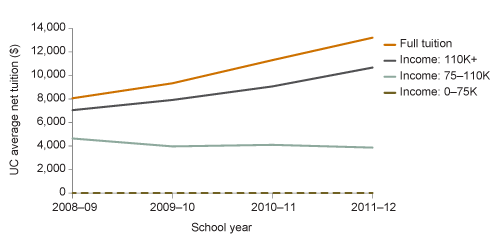
SOURCE: Author calculations based on data from IPEDS.
NOTE: Average net tuition is calculated as average tuition and fees at the system minus the average amount of grants and scholarships for first-time, full-time students who receive some form of federal financial aid. The calculations assume grants and scholarships are applied to tuition and fees first, rather than put toward other expenses. Average net tuition and full tuition for the systems are weighted by student.
Average tuition at CSU rose from $3,793 to $6,486 over this period, and students from families making more than $75,000 saw their net tuition rise at the same rate as the full tuition. Students from families making less than $75,000 saw little to no change in net tuition (Figure 4).
Figure 4. students from low-income families experienced small increases in net tuition as full tuition rose at csu
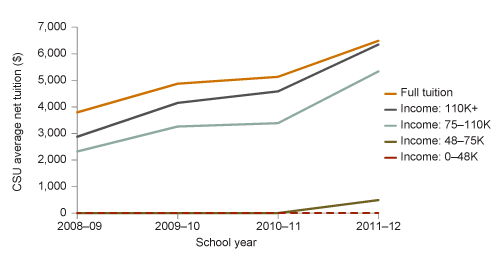
SOURCE: Author calculations based on data from IPEDS.
NOTE: Average net tuition is calculated as average tuition and fees at the system minus the average amount of grants and scholarships for first-time, full-time students who receive some form of federal financial aid. The calculations assume grants and scholarships are applied to tuition and fees first, rather than put toward other expenses. Average net tuition and tuition for the systems are weighted by student.
The Full Price of College
Tuition and fees are only a part of the full price of going to college. In addition to tuition and fees, students pay for room and board, books, and related educational and living expenses. The total amount a student pays for college can far exceed the cost of tuition. In 2011-2012, the estimated average price for attending a UC school was $30,472, of which 43 percent ($13,208) was tuition. At CSU, the estimated average price of attendance was $19,267, of which 34 percent ($6,486) was tuition. As shown above, many students from low- and middle-income families pay little or no tuition, and grants and scholarships can also cover other educational expenses. A student’s net price is calculated as the full price minus the amount in grants and scholarships. Driven by tuition increases, the full price to attend UC and CSU has grown in recent years. The net price for students from low- and middle-income families has increased at a slower pace than the full price of California’s public four-year universities. In fact, on average, students from California’s lowest-income families are paying no more than they did before the tuition increases at the UC (Figure 5). At CSU, students from low-income families saw small increases in average net price, while students from higher-income families saw larger increases (Figure 6).
Figure 5. net prices have not increased for uc students from low-income families
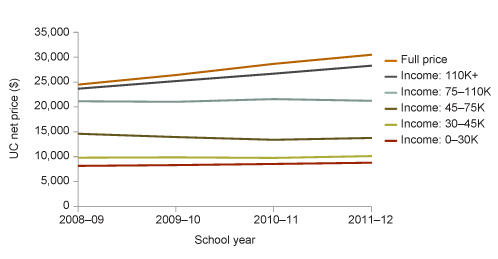
SOURCE: Author calculations based on data from IPEDS.
NOTE: Full price of attendance is the sum of published tuition and required fees, books and supplies, and the weighted average room and board and other expenses. Average net price calculated as average full price less the average amount of grants and scholarships for first-time, full-time students who receive some form of federal financial aid in each income category. Full price and average net price for the systems are weighted by student.
Figure 6. net prices for csu students from low-income families have increased modestly
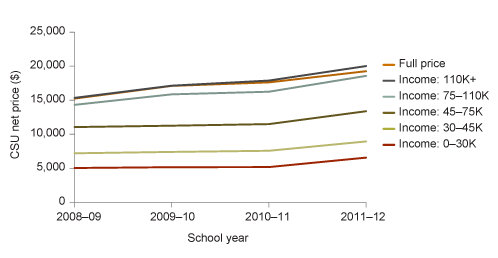
SOURCE: Author calculations based on data from IPEDS.
NOTE: Full price of attendance is the sum of published tuition and required fees, books and supplies, and the weighted average room and board and other expenses. Average net price calculated as average full price less the average amount of grants and scholarships for first-time, full-time students who receive some kind of federal financial aid in each income category. Full price and average net price for the systems are weighted by student.
It should be noted that even a modest increase in net prices for low-income students is cause for concern. The monetary increases may be smaller for low-income students-who are more likely to attend CSU than UC-but they represent a relatively large share of family incomes.11
Policy Implications
We have seen that most students whose families make less than $75,000 and who receive federal financial aid pay little to no tuition at CSU or UC, even after the tuition increases during the recent recession. Net prices for students from the lowest-income families have not increased at UC but they have risen slightly at CSU. Most of the recent tuition and cost increases have been paid by students from higher-income families and those who do not apply for or receive federal and/or state financial aid, regardless of income level.
Net tuition and net price are difficult to advertise to low- and middle-income families because they are highly individualized-they are dependent on a student’s exact family income, family size, and other financial and academic factors. Policymakers need to improve outreach to lower-income families who could benefit from low net tuition and net prices. Universities that receive federal funds are required to post net price calculators on their websites. Making it easier for students and parents to find and use these calculators can help them assess the difference between their estimated net prices and the full price.
A big part of the challenge is to reach low-income students who are eligible for but do not apply for financial aid. Most students from low-income families and increasing numbers of students from middle-income families are eligible for financial aid, but national data suggest many eligible students do not apply, leading to higher college costs for the students most in need of financial assistance. Nationwide, 94 percent of students from families with incomes under $30,000 fill out the FAFSA. But more than 10 percent of students from families making $30,000 to $48,000 and about 20 percent of students from families making $48,000 to $75,000 fail to fill out the FAFSA.12 This makes college much more expensive for many lower- and middle-class students.
Policies directed at inducing students to fill out FAFSA or California Dream Act applications and making these applications easier to fill out can lead to lower net prices and increased college access for low-income students in California. For instance, the state can motivate its public high schools to push students to apply for financial aid by making the percentage of students who fill out a FAFSA one of each school’s college and career readiness indicators. Also, new research suggests that there are ways to simplify the process of filling out a FAFSA, such as linking it to tax preparation or significantly reducing the number of questions on the form.13
As California has begun to restore funding to higher education, UC and CSU have responded to financial incentives from the state by freezing tuition at 2011-12 levels. It may also be possible for California policymakers to use the incentive of new funds to further align higher education outcomes with state goals. (This is the focus of a companion report, Higher Education in California: Performance Budgeting.) Given the economic importance of higher education and the large number of lower-income students in California’s public K-12 schools, making college widely accessible will remain a crucial state goal even if tuition does not continue to rise dramatically. An ongoing commitment to financial aid programs and effective outreach can help keep net tuition and net prices affordable for California’s low- and middle-income families.
Topics
Affordability Equity Higher Education

